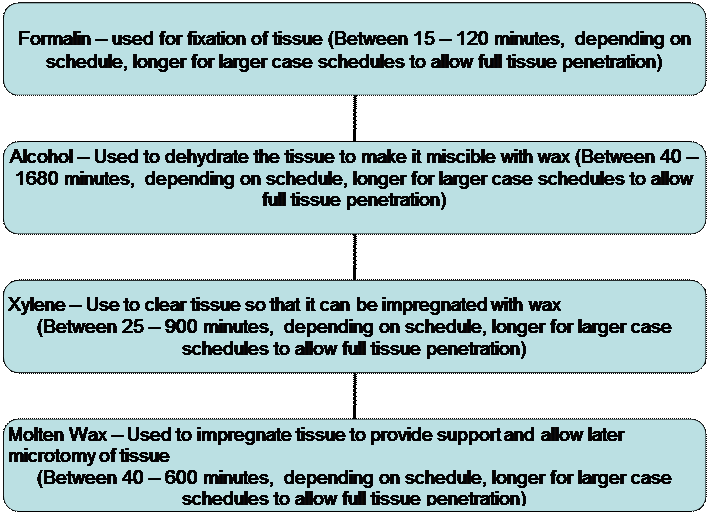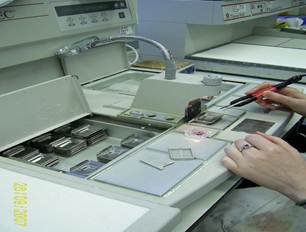
Histology Techniques - Tissue Processing and Embedding
- Processing - Formalin to wax
- Resins
- Processing Schedules Wax and Resin
- Embedding Tissue
Tissue processing, is required next step after fixation to allow tissue to be embedded in molten wax. There are three main stages involved in tissue processing. These are Fixation to make sure tissue is fixed properly in the required fixative, Dehydration via ethanol to remove any water in the tissue, Clearing to replace any water or ethanol with xylene, and finally Impregnation with molten wax, which are described on the chart below.

This procedure is required as tissue containing water is not normally miscible with paraffin wax. This is normally carried out on a processing machine in larger laboratories as it is more efficient and faster than by hand.
Paraffin wax does not provide a sufficiently hard matrix for cutting very thin sections for electron microscopy. Instead, resins are used. Epoxy resins are the most commonly employed embedding media, but acrylic resins are also used, particularly where immunohistochemistry is being used.
One benefit of using resin is that thinnner sections (0.35μm to 5μm) of resin-embedded tissue can also be cut for light microscopy.
One difference from the paraffin based technique is due to the immiscibility of most epoxy and acrylic resins with water this requires instead the use of dehydration, usually with ethanol.
Below are a list of machine schedules that can be used for processing.
| Processing Schedules | ||||||||||||||
|---|---|---|---|---|---|---|---|---|---|---|---|---|---|---|
| Short fixation - Small Biopsy Use | Time In Reagent (Minutes) | Overnight fixation - medium tissue | Time In Reagent (Minutes) | 3 day fixation - Supersize tissue | Time In Reagent (Minutes) | |||||||||
| Formalin | 15 | Formalin | 120 | Formalin | 60 | |||||||||
| Ethanol | 5 | Ethanol | 50 | Ethanol | 480 | |||||||||
| Ethanol | 5 | Ethanol | 50 | Ethanol | 300 | |||||||||
| Ethanol | 10 | Ethanol | 50 | Ethanol | 300 | |||||||||
| Ethanol | 10 | Ethanol | 50 | Ethanol | 300 | |||||||||
| Ethanol | 10 | Ethanol | 50 | Ethanol | 300 | |||||||||
| Xylene | 5 | Ethanol | 50 | Xylene | 300 | |||||||||
| Xylene | 10 | Xylene | 50 | Xylene | 300 | |||||||||
| Xylene | 10 | Xylene | 50 | Xylene | 300 | |||||||||
| Wax | 10 | Xylene | 50 | Wax | 200 | |||||||||
| Wax | 15 | Wax | 60 | Wax | 200 | |||||||||
| Wax | 15 | Wax | 90 | Wax | 200 | |||||||||
| - | - | Wax | 90 | - | - | |||||||||
| Renal Resin Processing Schedule | ||||||||||||||
|---|---|---|---|---|---|---|---|---|---|---|---|---|---|---|
| Solution and Why | Time In Reagent (Minutes) | |||||||||||||
| Formalin Used to fix the tissue as renal biopsies are often delivered fresh in saline. | 45 | |||||||||||||
| 70% Alcohol – Used to dehydrate the tissue as LR White is not miscible with water. | 120 | |||||||||||||
| 1:1 Absolute Alcohol: LRW – Used to dehydrate further the tissue, while the LR white is used to begin impregnation of the tissue | 30 | |||||||||||||
| LR White – Used to further impregnate the tissue | 45 | |||||||||||||
After processing of tissue, it is then ready to be embedded into a wax block, which is the next step before it is ready for cutting. In major laboratories a large scale embedding centre is used for this work, as shown in the picture below.
On the embedding centre, the tissue is placed into a wax filled metallic mould and then placed on Ice to cool before it is formed as shown above. A Cassette is often used to provide a structure and support for the tissue for later microtomy. |
